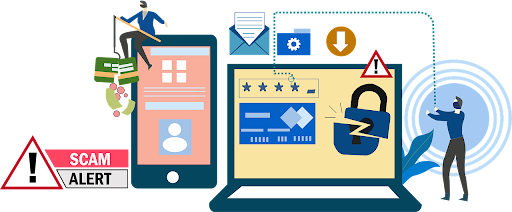Advanced Network Security Solutions: Staying Ahead of Cyber Threat
Advanced Network Security Solutions: Staying Ahead of Cyber Threat
In today’s digital landscape, staying ahead of cyber threats is crucial. As technology evolves, so do the tactics of cybercriminals. You must adopt advanced network security solutions to protect sensitive data and maintain trust in your systems. By proactively addressing vulnerabilities, you can secure your network and stay one step ahead of potential attackers.
Use a Firewall
A firewall serves as a critical defense in staying ahead of cyber threats by acting as a barrier between your internal network and external networks. It monitors incoming and outgoing traffic based on predetermined security rules and filters out malicious data. By choosing firewall as a service, you’re blocking unauthorized access while allowing legitimate communication, a firewall protects against potential breaches and intrusions. To maximize its effectiveness, ensure that it is properly configured and regularly updated to address emerging threats.

Employ both hardware and software firewalls for layered protection, and customize settings to align with your network’s specific needs. Regularly review firewall logs to detect suspicious activities early on. Proper utilization of a firewall not only fortifies your network’s security but also provides real-time insights into potential vulnerabilities, helping you stay one step ahead of cybercriminals.
Keep Software Updated
Software updates are crucial for staying ahead of cyber threats as they often include patches for vulnerabilities that cybercriminals could exploit. Regular updates ensure that security flaws are addressed promptly, reducing the risk of attacks. To effectively utilize software updates, enable automatic updates whenever possible to ensure the latest patches are applied without delay.
For software that doesn’t support automatic updates, establish a routine schedule to check for and install updates. Keeping an inventory of all software used, along with their respective update schedules, can help manage this process efficiently. Additionally, stay informed about the latest security threats and related patches by subscribing to security bulletins from software vendors. By maintaining up-to-date software, you can significantly enhance your network’s security and resilience against potential cyber-attacks.
Use Strong and Unique Passwords
Passwords are one of the most basic but vital lines of defense against cyber threats. Weak and easily guessable passwords make it easier for attackers to gain unauthorized access to your network. Here are some tips to achieve this:
- Length (12-16 characters)
- Complexity (mix of uppercase, lowercase, numbers and special characters)
- Unpredictability (nothing connected to you)
- Variety (unique for every account)
- Passphrases (compilation of random words)
- Substitutions and misspelling
Strong and unique passwords are vital for staying ahead of cyber threats because they significantly reduce the risk of unauthorized access. They make it harder for attackers to crack accounts and systems by employing brute force or other hacking techniques, thus bolstering your network’s overall security posture.
Enable Multi-Factor Authentication
Multi-factor authentication (MFA) adds an extra layer of security beyond just a password. By requiring two or more verification methods—such as something you know (password), something you have (security token), and something you are (biometric verification) — MFA significantly reduces the likelihood of unauthorized access.
Setting up MFA can often be done through your account’s security settings. First, enable MFA on your account, then add and verify a second method such as an authenticator app, SMS code, or biometrics. Regularly review and update your MFA methods to ensure they remain secure and up-to-date, further strengthening your defense against cyber threats.
Regular Backups
Backups ensure that critical data can be recovered in the event of a ransomware attack, hardware failure, or other catastrophic incidents. By maintaining up-to-date backups, you minimize downtime and data loss, allowing for a swift recovery of operations. To create effective backups, first determine what data needs to be backed up and how frequently.
Use automated backup solutions to ensure consistency and minimize human error, and store backups in multiple locations, including off-site or cloud storage, to safeguard against physical breaches. Regularly test your backups to verify data integrity and accessibility, ensuring that you can restore systems efficiently when needed.
Learn and Stay Informed
Continuous education and staying informed are essential for staying ahead of cyber threats, as they allow individuals and organizations to adapt to the ever-evolving landscape of cybercrime. By keeping abreast of the latest cybersecurity developments, threat vectors, and mitigation strategies, you can better preempt potential attacks. Subscribe to cybersecurity newsletters, follow reputable blogs, and participate in online courses and webinars to stay updated.

Encourage your team to obtain relevant certifications and attend industry conferences. Implement regular training sessions and simulated phishing exercises to enhance awareness and preparedness. By fostering a culture of continuous learning, you create a robust defense system that adapts quickly to new threats, ensuring your network remains secure against emerging cyber risks.
By implementing these advanced network security solutions, you take proactive steps to protect your sensitive data. Regularly updating your systems, using strong passwords, enabling multi-factor authentication, and maintaining backups will fortify your defenses against cyber threats. Stay informed and foster a culture of continuous learning to ensure your network remains secure and resilient against emerging cyber risks.



 WhatsApp Spy
WhatsApp Spy Facebook & Messenger Spy
Facebook & Messenger Spy Viber Spy
Viber Spy Instagram Spy
Instagram Spy Skype Spy
Skype Spy TikTok Spy
TikTok Spy Telegram Spy
Telegram Spy LinkedIn Spy
LinkedIn Spy Twitter Spy
Twitter Spy Youtube Spy
Youtube Spy Photo Spy
Photo Spy Video Spy
Video Spy Calls and Contacts Tracking
Calls and Contacts Tracking SMS & IM Chats
SMS & IM Chats Voice Capture
Voice Capture Image Capture
Image Capture Video Record
Video Record